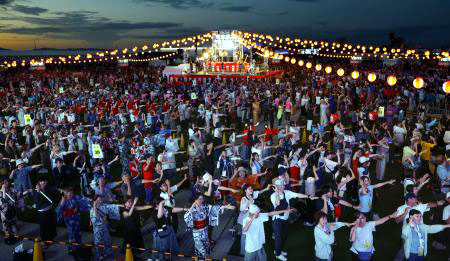
今や盆踊りは日本の垣根を越えて世界に広がりを見せています。日系移民が住み付いた南米のブラジルやアルゼンチン、ペルーやチリはもちろん、北米、ヨーロッパやアジア各地、数え上げたらきりがありません。その規模たるや、マレーシアで開催される盆踊り大会などは毎年約3万人以上が来場するというから驚きです。
今開催中の大阪万博では、7月26日、ギネス世界記録に挑戦という名目で、
・踊る人の人数を競う「最大の盆踊り」
・同時に盆踊りを踊った「最多国籍数」
を掲げて開催されました。現在の記録では、
【最大の盆踊り】2017年9月 八尾河内音頭まつり2,872人
【最多国籍数】現時点では記録なし(少なくとも50か国以上で記録達成)
ということだそうですが、目標が達成されたかどうかは定かではありません。
盆踊りのルーツはもちろん日本で、平安時代に広まった「念仏踊り」にあるといわれています。当初は、僧侶が念仏を唱えながら輪になって踊ることで、極楽往生を願う宗教的な儀式でした。この踊りが盂蘭盆会(うらぼんえ)と融合し、先祖供養の一環として発展したそうです。
お盆は、亡くなった先祖の霊が一時的に帰ってくるとされる時期。その霊を迎え、慰め、送り出すための踊りが盆踊りです。地域ごとに異なる音楽や振り付けがあり、たとえば秋田の西馬音内(にしもない)盆踊りや徳島の阿波踊りなどが有名ですが、日本全国各地、実に多種多様な盆踊りがあり、その伝統と奥深さには圧倒されます。
宗教的儀式から始まったこの盆踊りは、過去と現在、霊と人間、地域と世界をつなぐ「輪(和)」の象徴とも言えます。今では国境を越えて人々をつなぐ「平和の踊り」として進化しているのです。
*世界各地の盆踊りの様子はYouTubeでたくさん紹介されています。ぜひご覧になってください。
Bon Odori has now transcended Japan’s borders, spreading its joyful rhythm across the globe. From South American countries like Brazil, Argentina, Peru, and Chile—home to many Japanese immigrants—to North America, Europe, and various parts of Asia, its reach is astonishingly vast. In fact, the Bon Odori festival held annually in Malaysia reportedly draws over 30,000 attendees, a scale that surprises many.
At the ongoing Osaka Expo, a special Bon Odori event was held on July 26th under the banner of a Guinness World Record challenge:
- “Largest Bon Odori” by number of dancers
- “Most Nationalities Dancing Bon Odori Simultaneously”
As of now, the records stand as follows:
- Largest Bon Odori: 2,872 participants at the Yao Kawachi Ondo Festival in September 2017
- Most Nationalities: No official record yet, though it’s said that over 50 countries may have been represented
Whether the new goals were achieved remains uncertain.
The roots of Bon Odori lie in Japan, tracing back to the Heian period’s “Nembutsu Odori”—a Buddhist ritual where monks danced in a circle while chanting prayers, seeking rebirth in paradise. This dance later merged with the Urabon-e (Obon) festival, evolving into a tradition of ancestral remembrance.
Obon is a time when the spirits of departed ancestors are believed to return temporarily. Bon Odori is the dance performed to welcome, console, and send off these spirits. Each region has its own music and choreography—Akita’s Nishimonai Bon Odori and Tokushima’s Awa Odori are especially renowned. Across Japan, the diversity and depth of Bon Odori traditions are truly awe-inspiring.
What began as a religious rite has become a symbol of connection—a circle (“wa”) linking past and present, spirits and people, local communities and the world. Today, Bon Odori continues to evolve as a “dance of peace” that unites people across borders.
You can find many videos showcasing Bon Odori festivals around the world on YouTube. Please take a look and enjoy the vibrant scenes.
